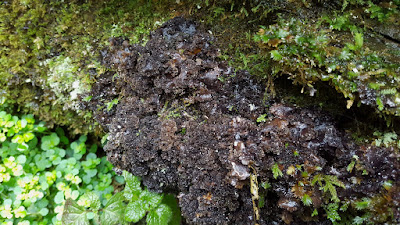I had two targets on the colliery spoil between the Blorenge and Blaenavon and failed on both:
Lophocolea bispinosa doesn't seem to have reached the eastern Valleys yet, and
Buxbaumia aphylla was always going to be a long-shot :-) The wind and drizzle didn't help.
Anyway, I made separate DAFOR lists for a heather/crowberry-dominated colliery tip face (21 spp including
Lophozia ventricosa silvicola and
Cephaloziella hampeana), and a much more open, parched tip top (6 spp), and also found some
Lophozia bicrenata on the side of a gully between two tips.
A short trip north to Cwm Ifor, where a stream has carved a narrow ravine at the junction of the Millstone Grit and Carboniferous Limestone, produced a completely different flora.
Neckera crispa was amazingly abundant and was fruiting copiously, and there were various other calcicoles including
Scapania aspera and
Jungermannia atrovirens, although I couldn't see any sign of several of the notable species I found in the ravine in 2000/2003. An outcrop of Millstone Grit above the ravine held abundant
Barbilophozia attenuata and there were a few patches of
Sphagnum squarrosum in a flush.
My entire 1.5 hour visit was spent in tetrad SO21K, which is one of the richest in VC35 with >200 species recorded. I visited many times between 1999 and 2003, including with Graham and with the Border Bryologists, so it was nice to return to old haunts. Perhaps surprisingly, given previous coverage, I added 11 species to the tetrad total, so the day was useful.




















































